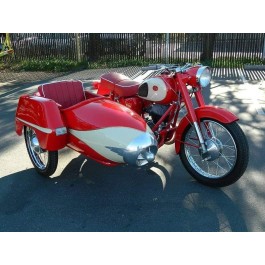Browse By
|
1968 PannoniaDescriptionA 1968 Pannonia. Made in Hungary.Manufactured 1951 to ca.1973. Pannonia two-stroke singles and twins were similar to Jawa and were built by Csepel. These machines were marketed as White Motorcycles in the United States in the mid 1960s. White motorcycles were built for export to the USA at the Csepel Motor Works in Hungary until 1975. Jack White contracted the Csepel Motor Works to build this unique motocrosser in 1965. White Motors, located in Santa Ana, California actually imported several different models of motorcycles which included 125 and 250cc machines for street, scrambles, and motocross. Jack White died in 2012 at the age of 90. Because of its low engine power only light sidecars can be attached to the Pannonia motorcycle. The weight of the sidecar mustn't exceed 140-155 pounds. Starting in the early fifties, the shipyard Vaci Hajogyar began building sidecars for the Csepel/Pannonia motorcycles. Located on the Danube, they named their new sidecars “Duna” (Hungarian for Danube). These were lightweight sidecars, (weighing approx. 155 pounds) with a steel-frame and a body first made of steel, and then later made of aluminum. The typical sign of the Duna sidecars was the “rocket-nose”. The production of these very elegant sidecars ended in 1975 along with the Pannonia. Detailed Information
Additional InformationAdditional Information
|



